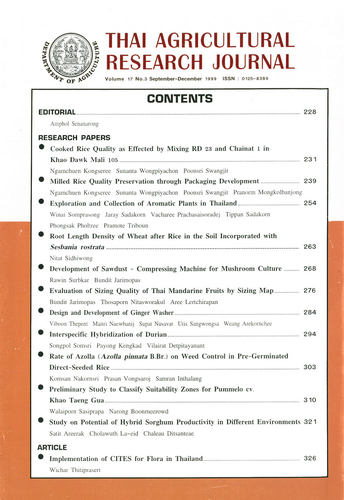Study on Potential of Hybrid Sorghum Productivity in Different Environments
DOI:
https://doi.org/10.14456/thaidoa-agres.1999.32Keywords:
potential, soil series, hybrid sorghum, farmer fieldAbstract
The sorghum productivity of 5 soil series including Takhli, Lop Buri, Thab Kwang, Wang Hai and Samo Thod was studied. Five hybrid and three pure line sorghum varieties were tested for grain yield and agronomic traits under those soil series in 1998 late rainy season on farmer field, Tak Fa and Nakhon Sawan. The experiment design was a randomized complete block design with 4 replications.rn The result showed that an interaction between the series of soil and varieties of sorghum was observed in grain yield. There was significant different between grain yield of sorghum under different soil series. rnThe result showed that an interaction between the series of soil and varieties of sorghum was observed in grain yield. There was significant different between grain yield of sorghum under different soil series. The Thab Kwang, Lop Buri, Takhli, Samo Thod and Wang Hai soil seriesproduced sorghum grain yield of 637, 555, 384, 309 and 118 kg/rai, respectively. The Thab Kwang soil series gave the highest grain yield because it was a sandy clay loam soil, slight alkaline soil and organic matter contents was 2.43% but Wang Hai series gave the lowest grain yield because it was a vlay soil, medium acied soil and organic matter content was 1.59%. In comparison between all combinations of different soil series and sorghum varieties, the combination of Thab Kwang soil series and sorghum hybrid Cargill 121 produced the highest grain yield of 722 kg/rai. Thab Kwang series was suitable for Cargill 121 because it gave high yield in that soil. Lop Buri, Takhli and Samo Thod Series were suitable for "KU 9501". Ku 9501 gave high viely because it had good seed germination, high number of head per area, high plant dry weight, high biomass and high leaf area index.
Downloads
Published
How to Cite
Issue
Section
License

This work is licensed under a Creative Commons Attribution-NonCommercial-NoDerivatives 4.0 International License.
Thai Agricultural Research Journal



